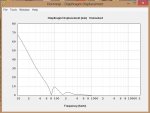Hi Andy,
It looks like this could only be a small part of your difficulties, but converting BW to Q is not enough to transfer settings between DSP platforms. I wrote an article (
668KB PDF) and made a presentation (
827KB PDF) about this.
Hi Bennet.
Thank you for the papers. Very interesting reading.
When transferring the Lab DSP settings referenced earlier, I used the an online tool from Sengpiel audio:
http://www.sengpielaudio.com/calculator-bandwidth.htm , to convert from bandwidth to Q.
After reading your papers I get it, that there are other factors, some of which are depending on the DSP hardware/architecture? This is very interesting stuff.
I have also used the method of 'reading out' the DSP setting from a 'certain' amp for a certain speaker and was able to manually replicate to Powersoft amps, by visually tailoring the FR curve. The result was acceptable. The copied DSP settings are still missing the phase correction part - which is next on the 'how to' list.
You are mentioning limiter behavior, which is also something I need to get into. I wonder if you want to copy from one amp to another, there is any other way but to push the amp (with power resistors connected) and measure with an L-PAD?
Further I am guessing that some amps like d&b audiotechnik D12 etc. are using dynamic EQ?
All in all, I reckon if you always measure the results of your DSP settings before using, it cannot go really wrong.
I need to read more about all this.


